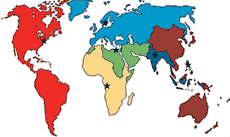


A class of natural or man-made substances, such as penicillin, that kill or
inhibit the growth of some micro-organisms.
(Source: GreenFacts, based on CoRIS,
Glossary![]()
A protein produced by the body's immune system that recognizes and helps fight
infections and other foreign substances in the body.
(Source: Gift of a Lifetime
Glossary![]()
An antimicrobial is a chemical substance which, at low concentrations, exerts an action against micro-organisms and destroys them or inhibits their growth.
Examples of antimicrobials targeting bacteria include antibiotics that act against infections in humans or animals and biocides such as disinfectants and preservatives. (Source: GreenFacts)
Bacteria are a major group of micro-organisms that live in soil, water, plants, organic matter, or the bodies of animals or people. They are microscopic and mostly unicellular, with a relatively simple cell structure.
Some bacteria cause diseases such as tetanus, typhoid fever, pneumonia, syphilis, cholera, and tuberculosis.
Bacteria play a role in the decomposition of organic matter and other chemical processes. (Source: GreenFacts)
Bacterial resistance is the capacity of bacteria to withstand
the effects of antibiotics or biocides that are intended to kill or control
them.
(Source: GreenFacts, based on the
![]()
Any technological application that uses biological systems, living organisms,
or derivatives thereof to make or modify products or processes for specific use.
(Source:
MA
![]()
The basic subunit of any living organism; the simplest unit that can exist as an independent living system. There are many different types of cells in complex organisms such as humans, each with specific characteristics. (Source: GreenFacts)
A clinical trial is a research study in human volunteers to answer specific
health questions.
(Source: U.S. Food and Drug Administration,
Basic Q&A on Clinical Trials![]()
Drug resistance occurs when a cell or bacteria becomes less sensitive to a specific drug. The clinical consequence of this is the decreased effectiveness of that drug to cure a disease or to improve a patient's symptoms.
Respiratory infections, HIV/AIDS, diarrhoeal diseases, tuberculosis and malaria are the leading killers among the infectious diseases. In recent years, all of these diseases have become resistant to first-line drugs. (Source: GreenFacts )
A protein that encourages a biochemical reaction, usually speeding it up.
Organisms could not function if they had no enzymes.
(Source:
NHGRI
NHGRI Talking Glossary of Genetic
Terms![]()
The functional and physical unit of heredity passed from parent to offspring.
Genes are pieces of DNA, and most genes contain the information for making a
specific protein.
(Source:
NHGRI
Talking Glossary of Genetic
Terms![]()
It is the growth of a parasite within the human body that causes illness. It can be a virus, a bacteria, a fungus or a protozoa. (Source: GreenFacts )
A disease or the incidence of a disease within a population. (Source: GreenFacts)
Organisms, including bacteria, viruses or cysts, capable of causing diseases
(typhoid, cholera, dysentery) in a host (such as a person). There are many types
of organisms which do NOT cause disease. These organisms are called
non-pathogenic.
(Source:
US EPA
US EPA Drinking Water Glossary, A Dictionary of Technical and Legal Terms
Related to Drinking
Water![]()
A characteristic or state whereby the needs of the present and local population can be met without compromising the ability of future generations or populations in other locations to meet their needs.
Measures taken to treat a physical or mental disease.
First-line therapy is the first type of therapy given for a condition or disease.
Second-line therapy is the treatment that is given when
initial treatment (first-line therapy) doesn't work, or stops working.
(Source: based on St Jude Hospital Medical Terminology & Drug
Database![]()
Tuberculosis (TB) is an infectious disease caused by a bacterium, most commonly Mycobacterium tuberculosis. It affects tissues in the human body, mainly the lungs (pulmonary tuberculosis). It causes small tumors that destroy the tissue.
Symptoms include cough, fatigue, weight loss, difficulty breathing, and fever. (Source: GreenFacts)
A virus is a small organism which can infect other biological organisms.
Viruses can only reproduce by invading and taking over cells as they lack the cellular machinery for self reproduction.
They cause diseases in human beings, animals, plants and bacteria.
Examples of human diseases caused by viruses include the common cold, influenza, small pox, AIDS, and cold sores. (Source: GreenFacts)
"The World Health Organization![]()
193 countries and two associate members are WHO’s membership. They meet every year at the World Health Assembly in Geneva to set policy for the Organization, approve the Organization’s budget, and every five years, to appoint the Director-General. Their work is supported by the 34-member Executive Board, which is elected by the Health Assembly. Six regional committees focus on health matters of a regional nature."
WHO's scientific publications are widely recognized as a reference source.
The WHO has a number of regional offices which address the specific issues of those regions.

| WHO African Region |
|
| WHO European Region |
|
| WHO Eastern Mediterranean Region |
|
| WHO Region of the Americas |
|
| WHO South-East Asia Region |
|
| WHO Western Pacific Region |
 Biological diversity (Part 3): challenges 2050 |  Biological diversity (Part 2): the objectives, actions and means at the horizon 2030 |  Biological diversity (Part 1): the context of the Convention |

This summary is free and ad-free, as is all of our content. You can help us remain free and independant as well as to develop new ways to communicate science by becoming a Patron!